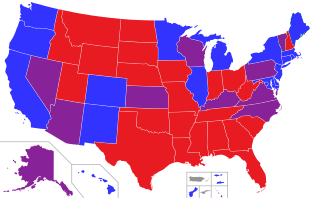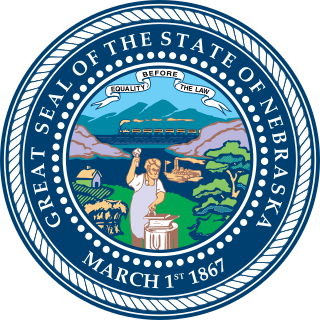This article needs additional citations for verification .(October 2013) |
A state senator is a member of a state's senate in the bicameral legislature of 49 U.S. states, or a member of the unicameral Nebraska Legislature.
This article needs additional citations for verification .(October 2013) |
A state senator is a member of a state's senate in the bicameral legislature of 49 U.S. states, or a member of the unicameral Nebraska Legislature.
A state senator is a member of an upper house in the bicameral legislatures of 50 U.S. states or a member of the unicameral Nebraska Legislature.
There are typically fewer state senators than there are members of a state's lower house; a senator's job is to represent the people at a higher level than a state representative in the lower house. [1] In the past, this meant that senators represented various geographic regions within a state, regardless of the population, as a way of balancing the power of the lower house, which was apportioned according to population. This system changed in 1964, when the Supreme Court of the United States announced in Reynolds v. Sims that state legislatures must apportion seats in both houses according to population. [2] However, the single-member district system remained, and as a result, the State Senates became redundant bodies, [3] as other solutions, such as abolition (as in Canada) or switching to statewide proportional representation (as in Australia) have not been adopted.

A senate is a deliberative assembly, often the upper house or chamber of a bicameral legislature. The name comes from the ancient Roman Senate, so-called as an assembly of the senior and therefore considered wiser and more experienced members of the society or ruling class. However the Roman Senate was not the ancestor or predecessor of modern parliamentarism in any sense, because the Roman senate was not a de jure legislative body.

In the United States, the state legislature is the legislative branch in each of the 50 U.S. states.

A member of parliament (MP) is the representative in parliament of the people who live in their electoral district. In many countries with bicameral parliaments, this term refers only to members of the lower house since upper house members often have a different title. The terms congressman/congresswoman or deputy are equivalent terms used in other jurisdictions. The term parliamentarian is also sometimes used for members of parliament, but this may also be used to refer to unelected government officials with specific roles in a parliament and other expert advisers on parliamentary procedure such as the Senate parliamentarian in the United States. The term is also used to the characteristic of performing the duties of a member of a legislature, for example: "The two party leaders often disagreed on issues, but both were excellent parliamentarians and cooperated to get many good things done."
Bicameralism is a type of legislature that is divided into two separate assemblies, chambers, or houses, known as a bicameral legislature. Bicameralism is distinguished from unicameralism, in which all members deliberate and vote as a single group. As of 2022, roughly 40% of the world's national legislatures are bicameral, while unicameralism represents 60% nationally and much more at the subnational level.
Unicameralism is a type of legislature consisting of one house or assembly that legislates and votes as one. Unicameralism has become an increasingly common type of legislature, making up nearly 60% of all national legislatures and an even greater share of subnational legislatures.

The Delaware General Assembly is the legislature of the U.S. state of Delaware. It is a bicameral legislature composed of the Delaware Senate with 21 senators and the Delaware House of Representatives with 41 representatives. It meets at Legislative Hall in Dover, convening on the second Tuesday of January of odd-numbered years, with a second session of the same Assembly convening likewise in even-numbered years. Normally the sessions are required to adjourn by the last day of June of the same calendar year. However the Governor can call a special session of the legislature at any time.

The Vermont General Assembly is the legislative body of the state of Vermont, in the United States. The Legislature is formally known as the "General Assembly", but the style of "Legislature" is commonly used, including by the body itself. The General Assembly is a bicameral legislature, consisting of the 150-member Vermont House of Representatives and the 30-member Vermont Senate. Members of the House are elected by single and two-member districts. 68 districts choose one member, and 41 choose two, with the term of service being two years. The Senate includes 30 Senators, elected by seven single-member and nine multi-member districts with two or three members each. It is the only state legislative body in the United States in which a third party has had continuous representation and been consecutively elected alongside Democrats and Republicans.

The New Jersey Legislature is the legislative branch of the government of the U.S. state of New Jersey. In its current form, as defined by the New Jersey Constitution of 1947, the Legislature consists of two houses: the General Assembly and the Senate. The Legislature meets in the New Jersey State House, in the state capital of Trenton.

The California State Senate is the upper house of the California State Legislature, the lower house being the California State Assembly. The state senate convenes, along with the state assembly, at the California State Capitol in Sacramento.
An upper house is one of two chambers of a bicameral legislature, the other chamber being the lower house. The house formally designated as the upper house is usually smaller and often has more restricted power than the lower house. A legislature composed of only one house is described as unicameral.

The North Dakota Legislative Assembly is the state legislature of the U.S. state of North Dakota. The Legislative Assembly consists of two chambers, the lower North Dakota House of Representatives, with 94 representatives, and the upper North Dakota Senate, with 47 senators. The state is divided into 47 constituent districts, with two representatives and one senator elected from each district. Due to the Legislative Assembly being a biennial legislature, with the House and Senate sitting for only 80 days in odd-numbered years, a Legislative Council oversees legislative affairs in the interim periods, doing longer-term studies of issues, and drafting legislation for consideration of both houses during the next session.
Reynolds v. Sims, 377 U.S. 533 (1964), was a landmark United States Supreme Court case in which the Court ruled that the electoral districts of state legislative chambers must be roughly equal in population. Along with Baker v. Carr (1962) and Wesberry v. Sanders (1964), it was part of a series of Warren Court cases that applied the principle of "one person, one vote" to U.S. legislative bodies.

The South Carolina General Assembly, also called the South Carolina Legislature, is the state legislature of the U.S. state of South Carolina. The legislature is bicameral and consists of the lower South Carolina House of Representatives and the upper South Carolina Senate. All together, the General Assembly consists of 170 members. The legislature convenes at the State House in Columbia.

"One man, one vote", "one person, one vote", or "one vote, one value" is a slogan the principle of equal representation in voting. This slogan is used by advocates of democracy and political equality, especially with regard to electoral reforms like universal suffrage and proportional representation.
In the United States, state governments are institutional units exercising functions of government at a level below that of the federal government. Each U.S. state's government holds legislative, executive, and judicial authority over a defined geographic territory. The United States comprises 50 states: 9 of the Thirteen Colonies that were already part of the United States at the time the Constitution took effect in 1789, 4 that ratified the Constitution after its commencement, plus 37 that have been admitted since by Congress as authorized under Article IV, Section 3 of the Constitution.
House of Representatives is the name of legislative bodies in many countries and sub-national entities. In many countries, the House of Representatives is the lower house of a bicameral legislature, with the corresponding upper house often called a "Senate". In some countries, the House of Representatives is the sole chamber of a unicameral legislature.

The Nebraska Legislature is the legislature of the U.S. state of Nebraska. The Legislature meets at the Nebraska State Capitol in Lincoln. With 49 members, known as "senators", the Nebraska Legislature is the smallest U.S. state legislature. A total of 25 members is required for a majority; however, in order to overcome a filibuster, a two-thirds vote of all members is required, which takes 33 votes.